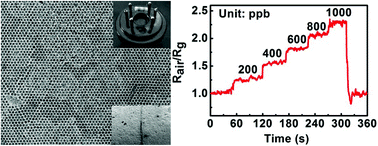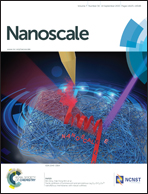In situ synthesis of porous array films on a filament induced micro-gap electrode pair and their use as resistance-type gas sensors with enhanced performances†
Abstract
Resistance-type metal–oxide semiconductor gas sensors with high sensitivity and low detection limit have been explored for practical applications. They require both sensing films with high sensitivity to target gases and an appropriate structure of the electrode-equipped substrate to support the sensing films, which is still challenging. In this paper, a new gas sensor of metal–oxide porous array films on a micro-gap electrode pair is designed and implemented by taking ZnO as a model material. First, a micro-gap electrode pair was constructed by sputtering deposition on a filament template, which was used as the sensor's supporting substrate. Then, the sensing film, made up of ZnO porous periodic arrays, was in situ synthesized onto the supporting substrate by a solution-dipping colloidal lithography strategy. The results demonstrated the validity of the strategy, and the as-designed sensor shows a small device-resistance, an enhanced sensing performance with high resolution and an ultralow detection limit. This work provides an alternative method to promote the practical application of resistance-type gas sensors.


 Please wait while we load your content...
Please wait while we load your content...